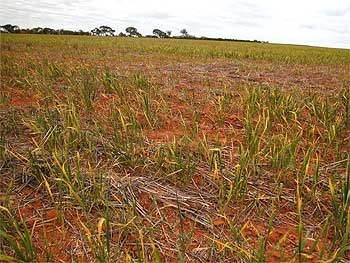Western Australia
August 22, 2006
The Department of
Agriculture and Food, Western Australia says the use of
tested seed is important to protect crops from Wheat Streak
Mosaic Virus (WSMV).
WSMV was found in self sown seed on several
properties in the Esperance and Kondinin regions in April this
year, and was identified for the first time last week in a sown
commercial wheat crop in Merredin.
|
 |
|
Wheat Streak Mosaic Virus (WSMV) detected
in sown commercial wheat crop in Merredin. |
Department of Agriculture principal plant
virologist Roger Jones said farmers should be looking out for
signs of Wheat Streak Mosaic Virus (WSMV), especially in early
sown crops.
“The Department advises farmers to sow seed
stocks from which a representative seed sample has been tested,
and the sample found to be healthy,” Dr Jones said.
“Seed samples can be tested for the virus, and
seed should not be retained from WSMV affected crops or where a
seed sample tests positive,” Dr Jones emphasised.
“AGWEST Plant Laboratories confirmed the virus in
the sown commercial wheat crop last week after testing a sample
from the Merredin area,” Dr Jones said.
”Landmark consultant Scott Thomson sent the
sample in on behalf of a grower who became concerned about an
early sown wheat crop in which all the plants had pale green
streaked leaves with yellowing of leaf tips and stunted growth,”
he said.
Dr Jones said that in early sowing situations
Wheat Streak Mosaic Virus could significantly reduce the yield
and grain quality of wheat, although experience with the disease
under Western Australian conditions was still very limited at
this stage.
“Early sown crops are at higher risk because of
the potential for the virus vector, wheat leaf curl mite, to be
active in spreading the virus within the crop at young growth
stages prior to cold winter months,” he said.
“The wheat curl mite vector survives the dry
summer period in green bridge growth consisting of volunteer
cereals and grasses.”
Farmers who suspect Wheat Streak Mosaic Virus in
their wheat crops can send shoot samples into AGWEST Plant
Laboratories for identification.
Dr Jones said retention of seed grain from crops
carrying the virus should be avoided at harvest.
“Because the virus is transmitted through wheat
seed, the Department is currently developing a seed test, with
support from the Grains Research and Development Corporation.”
Dr Jones said.
“It is expected that an initial testing service
will be available to farmers to test suspect seed stocks in time
for next year’s sowing.”
Dr Jones said that unlike the situation with some
aphid transmitted viruses, pesticides were not effective against
the mite vector, and there were no known wheat varieties
resistant to the virus.
“Ensuring sowing of seed stocks from which a
representative seed sample has been tested and found free, and
controlling the green bridge before planting wheat in paddocks
are the only control strategies currently available,” Dr Jones
advised. |